Kuppan T. Heat Exchanger Design Handbook
Подождите немного. Документ загружается.

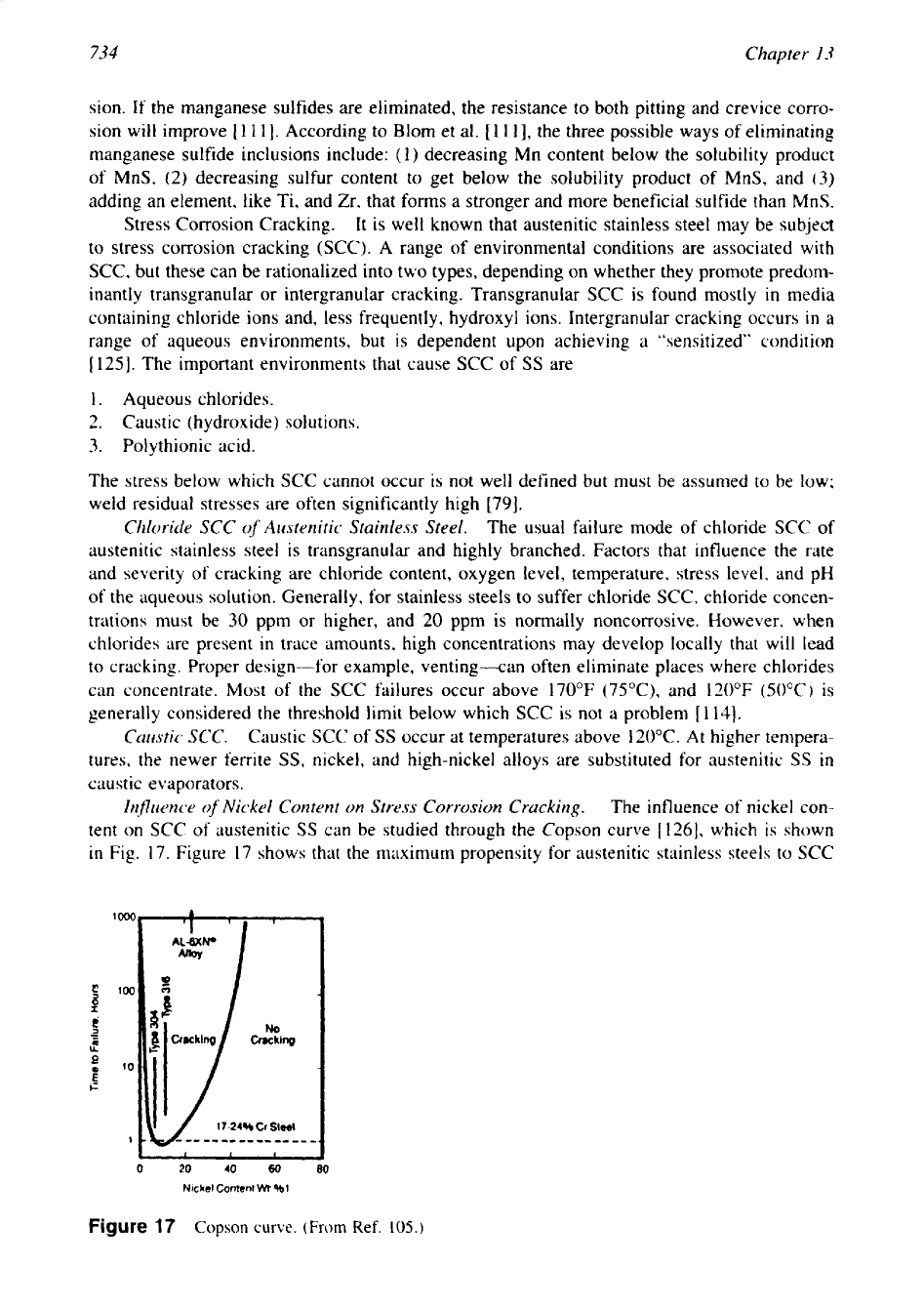
734
Chapter
I3
sion. If the manganese sulfides are eliminated, the resistance
to
both pitting and crevice corro-
sion will improve
[
1 1 11. According to Blom et al.
[
11
11, the three possible ways of eliminating
manganese sulfide inclusions include:
(
1) decreasing Mn content below the solubility product
of MnS, (2) decreasing sulfur content
to
get below the solubility product of MnS, and
(3)
adding an element, like Ti, and Zr. that forms a stronger and more beneficial sulfide than MnS.
Stress Corrosion Cracking.
It
is well known that austenitic stainless steel may be subject
to stress corrosion cracking (SCC).
A
range of environmental conditions are associated with
SCC, but these can be rationalized into
two
types, depending on whether they promote predom-
inantly transgranular or intergranular cracking. Transgranular SCC is found mostly
in
media
containing chloride ions and, less frequently, hydroxyl ions. Intergranular cracking occurs
in
a
range of aqueous environments, but
is
dependent upon achieving a “sensitized” condition
[
1251. The important environments that cause SCC of
SS
are
1.
Aqueous chlorides.
2. Caustic (hydroxide) solutions.
3.
Polythionic acid.
The stress below which SCC cannot occur is not well defined but must be assumed to be
low;
weld residual stresses are often significantly high
[79].
Chloride
SCC
of
Airstenitic Stainless Steel.
The usual failure mode of chloride
SCC
of
austenitic stainless steel is transgranular and highly branched. Factors that influence the rate
and severity of cracking are chloride content, oxygen level, temperature, stress level, and
pH
of the aqueous solution. Generally, for stainless steels to suffer chloride SCC, chloride concen-
trations must be
30
ppm or higher, and
20
ppm is normally noncorrosive. However, when
chlorides are present
in
trace amounts, high concentrations may develop locally that will lead
to cracking. Proper design-for example, venting-can often eliminate places where chlorides
can concentrate. Most of the SCC failures occur above 170°F (75”C), and 120°F (50°C) is
generally considered the threshold limit below which SCC is not a problem
[
1141.
Cniistk
SCC.
Caustic SCC of
SS
occur at temperatures above 120°C. At higher tempera-
tures, the newer ferrite
SS,
nickel, and high-nickel alloys are substituted for austenitic
SS
in
caustic evaporators.
Inflirence
of
Nickel Content
on
Stress Corrosion Cracking.
The influence of nickel con-
tent on SCC of austenitic
SS
can be studied through the Copson curve
[
1261, which is shown
in
Fig.
17.
Figure
17
shows
that
the maximum propensity for austenitic stainless steels to SCC
0
20
40
60
00
Nickel
ContenlW%l
Figure
17
Copson
curve.
(From
Ref.
105.)
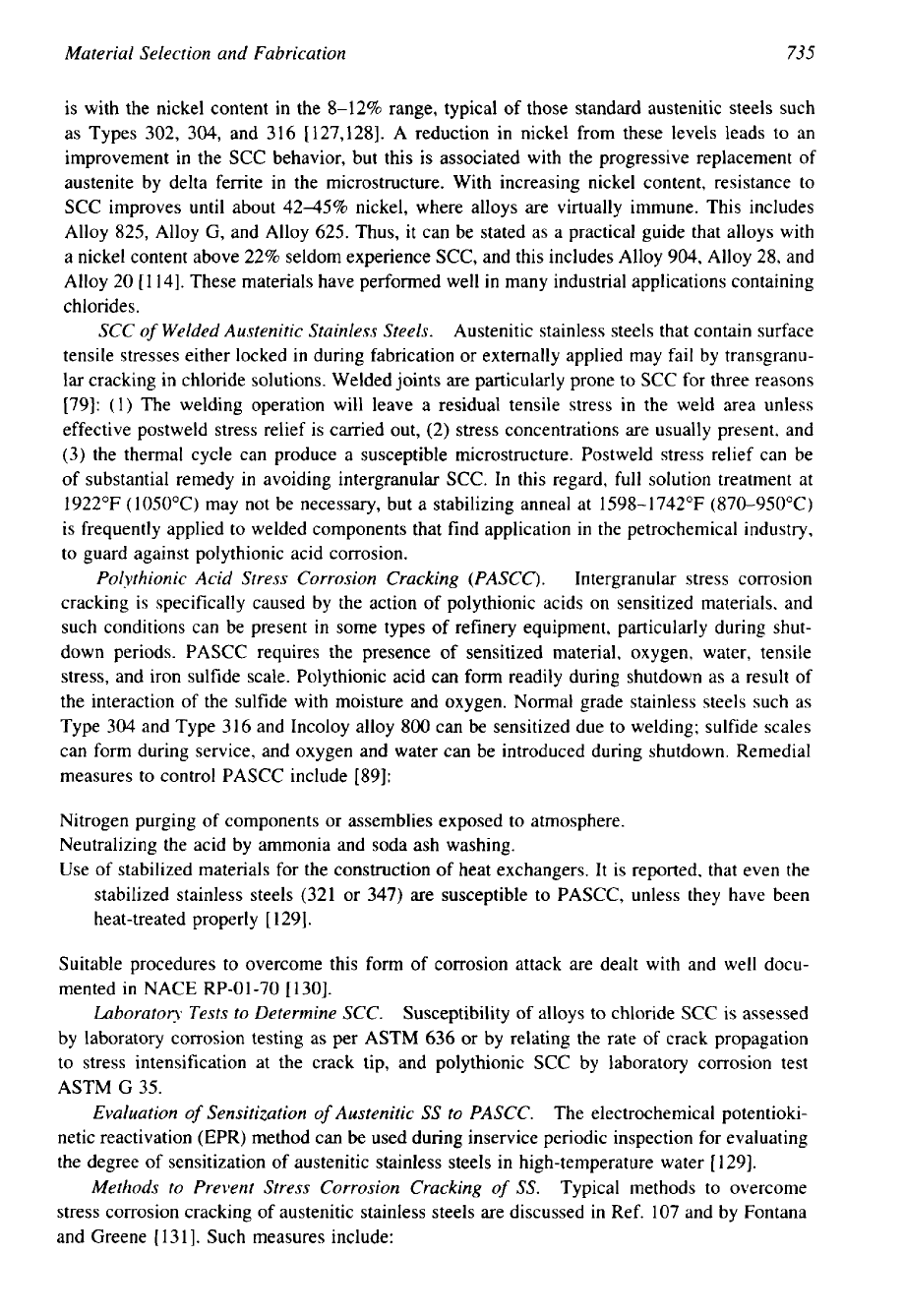
735
Material Selection and Fabrication
is with the nickel content in the 8-12% range, typical of those standard austenitic steels such
as Types 302, 304, and 316 [127,128]. A reduction in nickel from these levels leads to an
improvement in the SCC behavior, but this is associated with the progressive replacement of
austenite by delta ferrite in the microstructure. With increasing nickel content, resistance to
SCC improves until about 4245% nickel, where alloys are virtually immune. This includes
Alloy 825, Alloy
G,
and Alloy 625. Thus, it can be stated as a practical guide that alloys with
a nickel content above 22% seldom experience SCC, and this includes Alloy 904, Alloy 28, and
Alloy 20
[
1
141. These materials have performed well in many industrial applications containing
chlorides.
SCC
of
Welded Austenitic Stainless Steels.
Austenitic stainless steels that contain surface
tensile stresses either locked in during fabrication or externally applied may fail by transgranu-
lar cracking in chloride solutions. Welded joints are particularly prone to SCC for three reasons
[79]:
(1)
The welding operation will leave a residual tensile stress in the weld area unless
effective postweld stress relief is carried out, (2) stress concentrations are usually present, and
(3) the thermal cycle can produce a susceptible microstructure. Postweld stress relief can be
of substantial remedy in avoiding intergranular SCC. In this regard, full solution treatment at
1922°F
(
1050°C) may not be necessary, but a stabilizing anneal at 1598-1 742°F (870-950°C)
is frequently applied to welded components that find application in the petrochemical industry,
to guard against polythionic acid corrosion.
Polythionic Acid Stress Corrosion Cracking (PASCC).
Intergranular stress corrosion
cracking is specifically caused by the action of polythionic acids on sensitized materials, and
such conditions can be present in some types
of
refinery equipment, particularly during shut-
down periods. PASCC requires the presence of sensitized material, oxygen, water, tensile
stress, and iron sulfide scale. Polythionic acid can form readily during shutdown as a result of
the interaction of the sulfide with moisture and oxygen. Normal grade stainless steels such as
Type 304 and Type 316 and Incoloy alloy
800
can be sensitized due to welding; sulfide scales
can form during service, and oxygen and water can be introduced during shutdown. Remedial
measures to control PASCC include [89]:
Nitrogen purging of components or assemblies exposed to atmosphere.
Neutralizing the acid by ammonia and soda ash washing.
Use of stabilized materials for the construction of heat exchangers. It is reported, that even the
stabilized stainless steels (321 or
347)
are susceptible to PASCC, unless they have been
heat-treated properly
[
1291.
Suitable procedures to overcome this form of corrosion attack are dealt with and well docu-
mented in NACE RP-01-70 [130].
Laboratory Tests
to
Determine SCC.
Susceptibility of alloys to chloride SCC is assessed
by laboratory corrosion testing as per ASTM
636
or by relating the rate of crack propagation
to stress intensification at the crack tip, and polythionic SCC by laboratory corrosion test
ASTM G 35.
Evaluation
of
Sensitization
of
Austenitic
SS
to PASCC.
The electrochemical potentioki-
netic reactivation (EPR) method can be used during inservice periodic inspection for evaluating
the degree of sensitization of austenitic stainless steels in high-temperature water
[
1291.
Methods to Prevent Stress Corrosion Cracking
of
SS.
Typical methods to overcome
stress corrosion cracking of austenitic stainless steels are discussed in Ref. 107 and by Fontana
and Greene [131]. Such measures include:
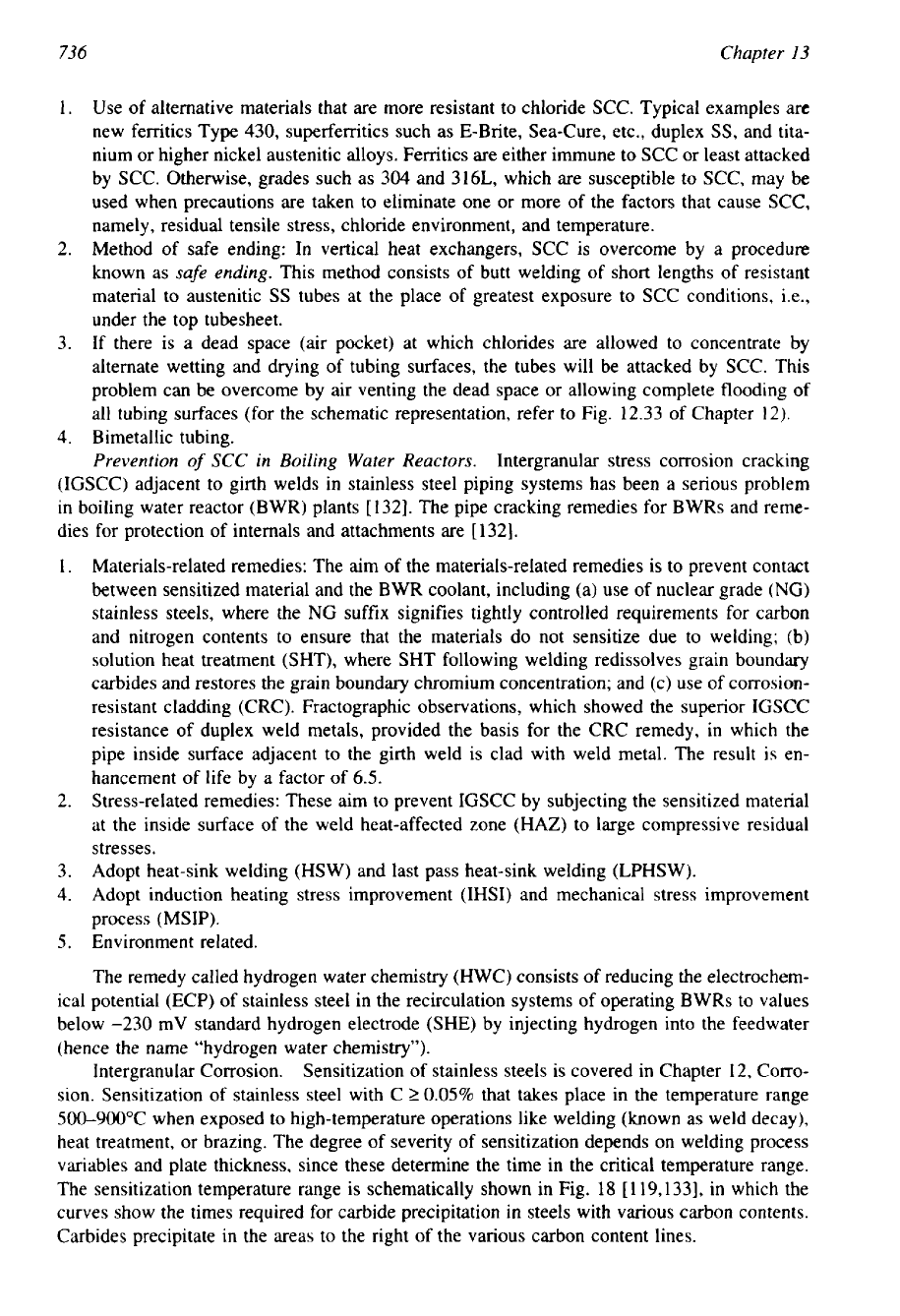
736
Chapter
13
1. Use of alternative materials that are more resistant to chloride SCC. Typical examples are
new ferritics Type 430, superferritics such as E-Brite, Sea-Cure, etc., duplex
SS,
and tita-
nium or higher nickel austenitic alloys. Ferritics are either immune to SCC or least attacked
by SCC. Otherwise, grades such as
304
and 316L, which are susceptible to SCC, may
be
used when precautions are taken to eliminate one or more of the factors that cause SCC,
namely, residual tensile stress, chloride environment, and temperature.
2.
Method of safe ending: In vertical heat exchangers, SCC is overcome by a procedure
known as
safe ending.
This method consists of butt welding of short lengths of resistant
material to austenitic
SS
tubes at the place of greatest exposure to SCC conditions, i.e.,
under the top tubesheet.
3.
If there is a dead space (air pocket) at which chlorides are allowed to concentrate
by
alternate wetting and drying of tubing surfaces, the tubes will be attacked by SCC. This
problem can
be
overcome by air venting the dead space or allowing complete flooding of
all tubing surfaces (for the schematic representation, refer to Fig. 12.33 of Chapter 12).
4.
Bimetallic tubing.
Prevention
of
SCC
in
Boiling Water Reactors.
Intergranular stress corrosion cracking
(IGSCC) adjacent to girth welds in stainless steel piping systems has been a serious problem
in boiling water reactor (BWR) plants
[
1321. The pipe cracking remedies for BWRs and reme-
dies for protection of internals and attachments are [132].
1.
Materials-related remedies: The aim
of
the materials-related remedies is to prevent contact
between sensitized material and the BWR coolant, including (a) use of nuclear grade
(NG)
stainless steels, where the NG suffix signifies tightly controlled requirements for carbon
and nitrogen contents to ensure that the materials do not sensitize due to welding;
(b)
solution heat treatment (SHT), where SHT following welding redissolves grain boundary
carbides and restores the grain boundary chromium concentration; and (c) use of corrosion-
resistant cladding (CRC). Fractographic observations, which showed the superior IGSCC
resistance of duplex weld metals, provided the basis for the CRC remedy, in which the
pipe inside surface adjacent to the girth weld is clad with weld metal. The result
is
en-
hancement of life by a factor of
6.5.
2.
Stress-related remedies: These aim to prevent IGSCC by subjecting the sensitized material
at the inside surface of the weld heat-affected zone (HAZ) to large compressive residual
stresses.
3. Adopt heat-sink welding (HSW) and last pass heat-sink welding (LPHSW).
4.
Adopt induction heating stress improvement (IHSI) and mechanical stress improvement
process (MSIP).
5.
Environment related.
The remedy called hydrogen water chemistry (HWC) consists of reducing the electrochem-
ical potential (ECP) of stainless steel in the recirculation systems of operating BWRs to values
below -230 mV standard hydrogen electrode (SHE) by injecting hydrogen into the feedwater
(hence the name “hydrogen water chemistry”).
Intergranular Corrosion.
Sensitization of stainless steels is covered in Chapter 12, COKO-
sion. Sensitization of stainless steel with C
2
0.05%
that takes place in the temperature range
500-900°C
when exposed to high-temperature operations like welding (known as weld decay),
heat treatment, or brazing. The degree of severity of sensitization depends on welding process
variables and plate thickness, since these determine the time in the critical temperature range.
The sensitization temperature range is schematically shown in Fig.
18
[
119,1331, in which the
curves show the times required for carbide precipitation in steels with various carbon contents.
Carbides precipitate in the areas to the right of the various carbon content lines.
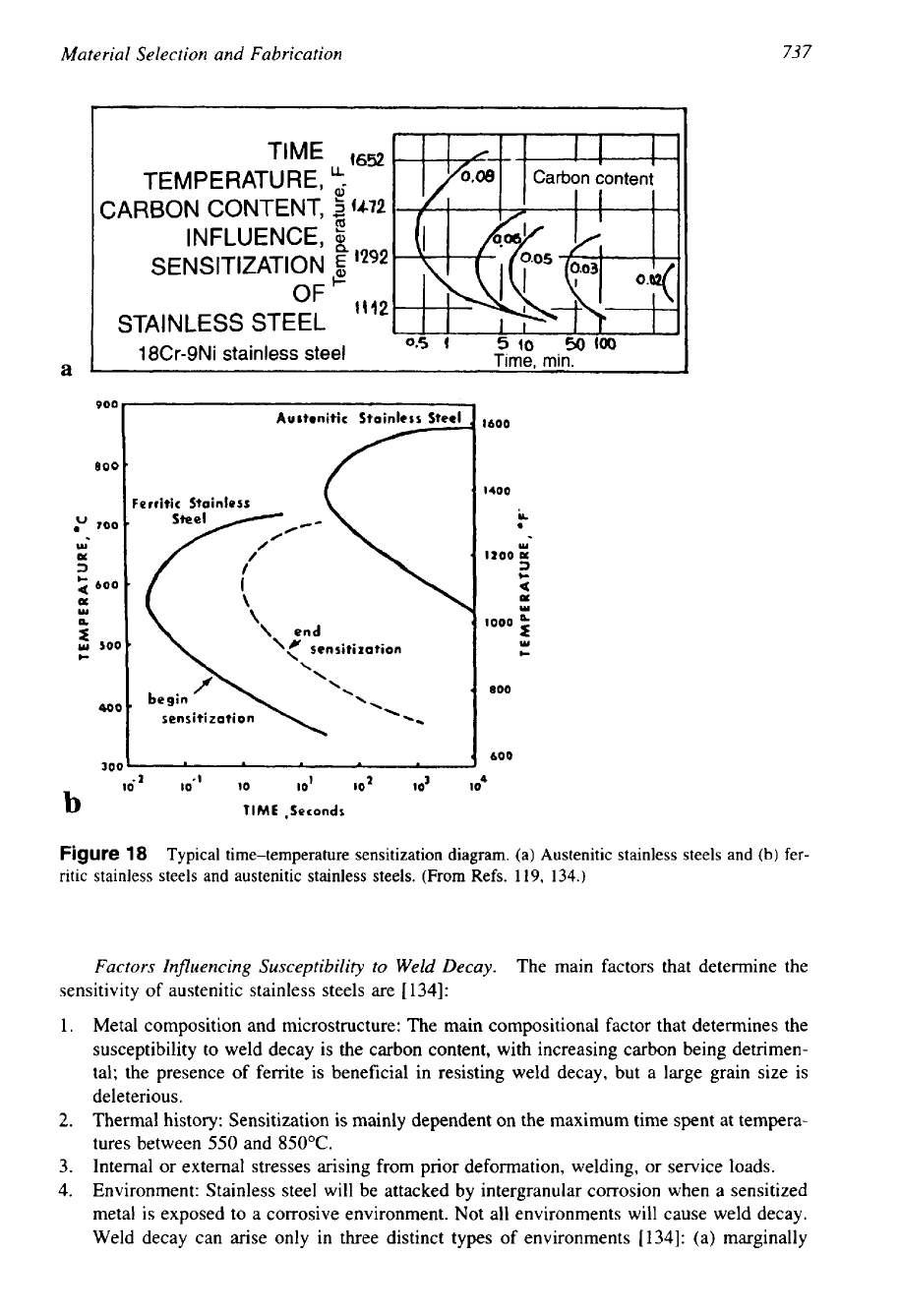
Material Selection and Fabrication
73
7
900
1600
800
1400
y.
,"
700
0
UI
YI
a
1200
3
3
c
c
4
600
U
a
PL
UI
w
0
1000
2
z
soa
w
c
c
8
00
4OC
600
JO(
lol
IO~
10'
Id
to
I
10
b
TIME
,Seconds
Figure
18
Typical time-temperature sensitization diagram. (a) Austenitic stainless steels and
(b)
fer-
ritic stainless steels and austenitic stainless steels. (From Refs.
119,
134.)
Factors Influencing Susceptibility to Weld
Decay.
The main factors that determine the
sensitivity of austenitic stainless steels are
[
1341:
1.
Metal composition and microstructure: The main compositional factor that determines the
susceptibility to weld decay is the carbon content, with increasing carbon being detrimen-
tal; the presence of ferrite is beneficial in resisting weld decay, but a large grain size is
deleterious.
2.
Thermal history: Sensitization is mainly dependent on the maximum time spent at tempera-
tures between
550
and
850°C.
3.
Internal or external stresses arising from prior deformation, welding, or service loads.
4.
Environment: Stainless steel will be attacked by intergranular corrosion when a sensitized
metal is exposed to a corrosive environment. Not all environments will cause weld decay.
Weld decay can arise only in three distinct types of environments
[134]:
(a) marginally
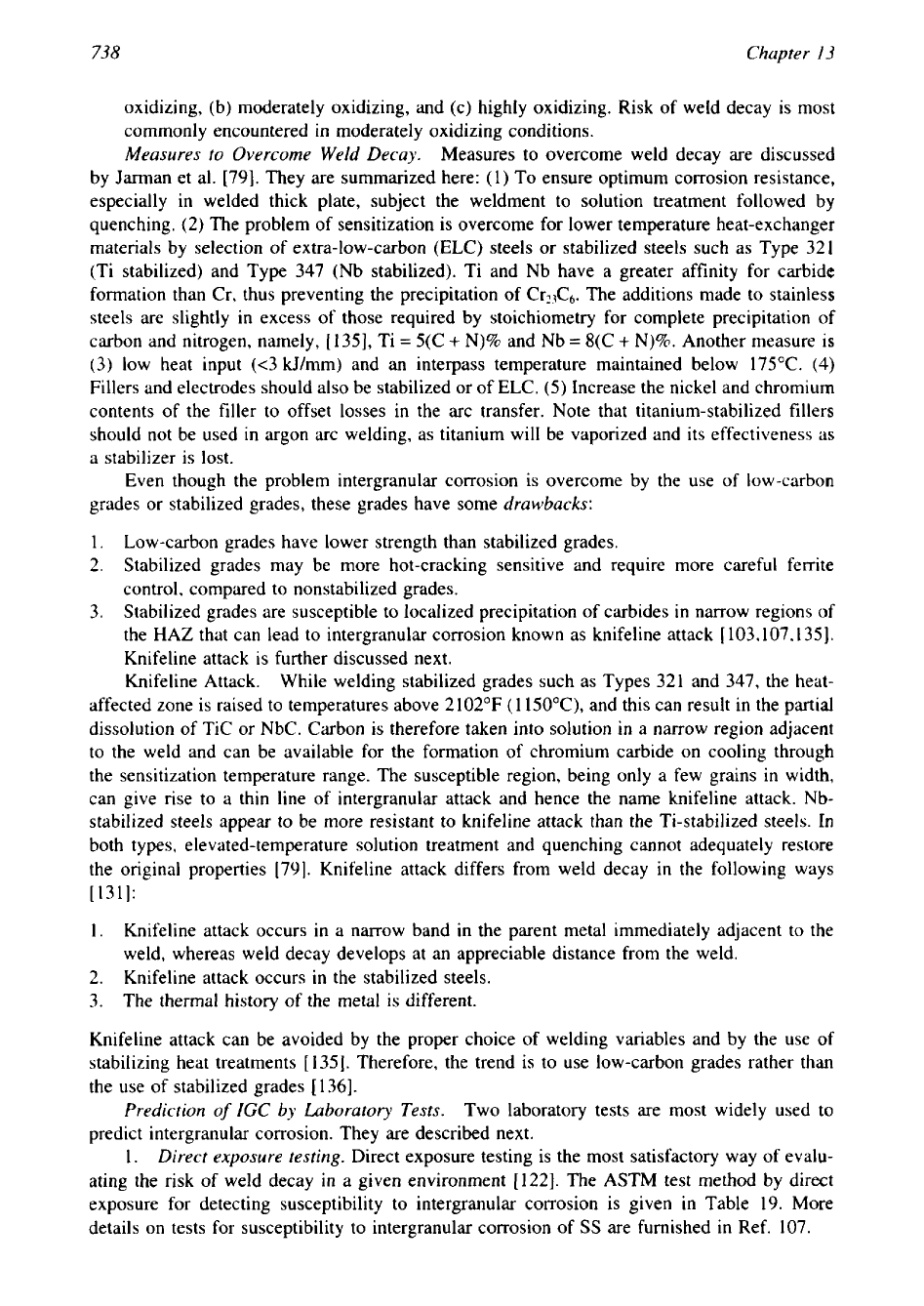
738
Chapter
13
oxidizing, (b) moderately oxidizing, and (c) highly oxidizing. Risk of weld decay is most
commonly encountered in moderately oxidizing conditions.
Measures to Overcome Weld Decay.
Measures
to
overcome weld decay are discussed
by Jarman et al.
[79].
They are summarized here:
(1)
To ensure optimum corrosion resistance,
especially in welded thick plate, subject the weldment to solution treatment followed by
quenching.
(2)
The problem of sensitization is overcome for lower temperature heat-exchanger
materials by selection of extra-low-carbon (ELC) steels or stabilized steels such as Type
321
(Ti stabilized) and Type
347
(Nb
stabilized). Ti and Nb have a greater affinity for carbide
formation than Cr, thus preventing the precipitation of Cr&. The additions made to stainless
steels are slightly in excess of those required by stoichiometry for complete precipitation
of
carbon and nitrogen, namely,
[
1351,
Ti
=
5(C
+
N)%
and Nb
=
8(C
+
N)%.
Another measure is
(3)
low heat input
(<3
kJ/mm) and
an
interpass temperature maintained below
175°C. (4)
Fillers and electrodes should also be stabilized or of ELC.
(5)
Increase the nickel and chromium
contents of the filler to offset losses in the arc transfer. Note that titanium-stabilized fillers
should not be used
in
argon arc welding, as titanium will be vaporized and its effectiveness
as
a stabilizer is lost.
Even though the problem intergranular corrosion is overcome by the use of low-carbon
grades or stabilized grades, these grades have some
drawbacks:
1.
Low-carbon grades have lower strength than stabilized grades.
2.
Stabilized grades may be more hot-cracking sensitive and require more careful ferrite
control, compared to nonstabilized grades.
3.
Stabilized grades are susceptible to localized precipitation of carbides in narrow regions
of
the HAZ that can lead to intergranular corrosion known as knifeline attack
[103,107,135].
Knifeline attack is further discussed next.
Knifeline Attack. While welding stabilized grades such as Types
321
and
347,
the heat-
affected zone is raised to temperatures above
2102°F
(1
150°C),
and this can result in the partial
dissolution of TIC or NbC. Carbon is therefore taken into solution in a narrow region adjacent
to the weld and can be available for the formation of chromium carbide on cooling through
the sensitization temperature range. The susceptible region, being only a few grains in width,
can give rise to a thin line of intergranular attack and hence the name knifeline attack.
Nb-
stabilized steels appear to be more resistant to knifeline attack than the Ti-stabilized steels. In
both types, elevated-temperature solution treatment and quenching cannot adequately restore
the original properties
[79].
Knifeline attack differs from weld decay in the following ways
[131]:
1.
Knifeline attack occurs in a narrow band in the parent metal immediately adjacent to the
weld, whereas weld decay develops at an appreciable distance from the weld.
2.
Knifeline attack occurs in the stabilized steels.
3.
The thermal history of the metal is different.
Knifeline attack can be avoided by the proper choice of welding variables and by the use of
stabilizing heat treatments
[
1351.
Therefore, the trend is to use low-carbon grades rather than
the use of stabilized grades
[
1361.
Prediction
of
IGC
by Laboratory Tests.
Two laboratory tests are most widely used to
predict intergranular corrosion. They are described next.
1.
Direct exposure testing.
Direct exposure testing is the most satisfactory way of evalu-
ating the risk of weld decay
in
a given environment
[
1221.
The
ASTM
test method by direct
exposure for detecting susceptibility to intergranular corrosion is given in Table
19.
More
details on tests for susceptibility to intergranular corrosion of
SS
are furnished
in
Ref.
107.
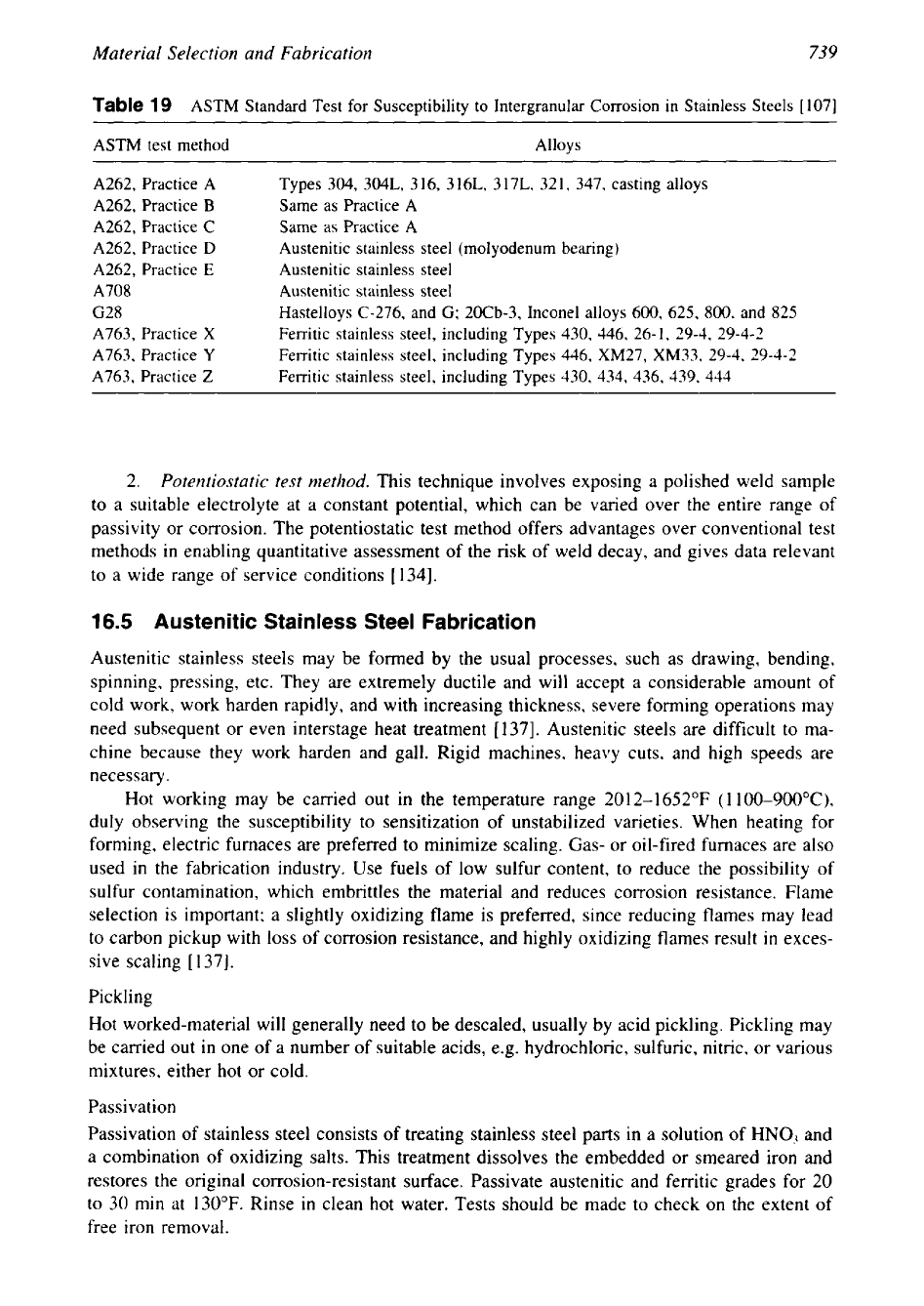
739
Material Selection and Fabrication
Table
19
ASTM Standard Test for Susceptibility to Intergranular Corrosion in Stainless Steels
[
1071
ASTM test method Alloys
A262, Practice A
Types
304,
304L,
316, 316L, 317L, 321, 347, casting alloys
A262, Practice
B
Same as Practice A
A262, Practice
C
Same
as
Practice A
A262, Practice
D
Austenitic stainless steel (molyodenum bearing)
A262, Practice
E
Austenitic stainless steel
A708
Austenitic stainless steel
G28
Hastelloys C-276, and
G;
20Cb-3, Inconel alloys 600, 625,
800,
and 825
A763, Practice
X
Ferritic stainless steel, including Types 430, 446, 26-
1,
29-4, 29-4-2
A763, Practice
Y
Ferritic stainless steel, including Types 446, XM27, XM33, 29-4, 29-4-2
A763, Practice
Z
Ferritic stainless steel, including Types 430, 434, 436, 439, 444
2. Potentiostatic test method.
This technique involves exposing a polished weld sample
to a suitable electrolyte at a constant potential, which can be varied over the entire range of
passivity or corrosion. The potentiostatic test method offers advantages over conventional test
methods
in
enabling quantitative assessment of the risk of weld decay, and gives data relevant
to a wide range of service conditions [134].
16.5
Austenitic Stainless Steel Fabrication
Austenitic stainless steels may be formed by the usual processes, such as drawing, bending,
spinning, pressing, etc. They are extremely ductile and will accept a considerable amount of
cold work, work harden rapidly, and with increasing thickness, severe forming operations may
need subsequent or even interstage heat treatment [137]. Austenitic steels are difficult to ma-
chine because they work harden and gall. Rigid machines, heavy cuts, and high speeds are
necessary.
Hot working may be carried out in the temperature range 201 2-1652°F (1 100-9OO0C),
duly observing the susceptibility to sensitization of unstabilized varieties. When heating for
forming, electric furnaces are preferred to minimize scaling. Gas- or oil-fired furnaces are also
used in the fabrication industry. Use fuels of low sulfur content, to reduce the possibility of
sulfur contamination, which embrittles the material and reduces corrosion resistance. Flame
selection is important; a slightly oxidizing flame is preferred, since reducing flames may lead
to carbon pickup with loss of corrosion resistance, and highly oxidizing flames result
in
exces-
sive scaling
[
1371.
Pickling
Hot worked-material will generally need to be descaled, usually by acid pickling. Pickling may
be carried out in one of a number of suitable acids, e.g. hydrochloric, sulfuric, nitric, or various
mixtures, either hot or cold.
Passivation
Passivation of stainless steel consists of treating stainless steel parts in a solution of
HN03
and
a combination of oxidizing salts. This treatment dissolves the embedded or smeared iron and
restores the original corrosion-resistant surface. Passivate austenitic and ferritic grades for
20
to 30 min at 130°F. Rinse in clean hot water. Tests should be made to check on the extent of
free iron removal.
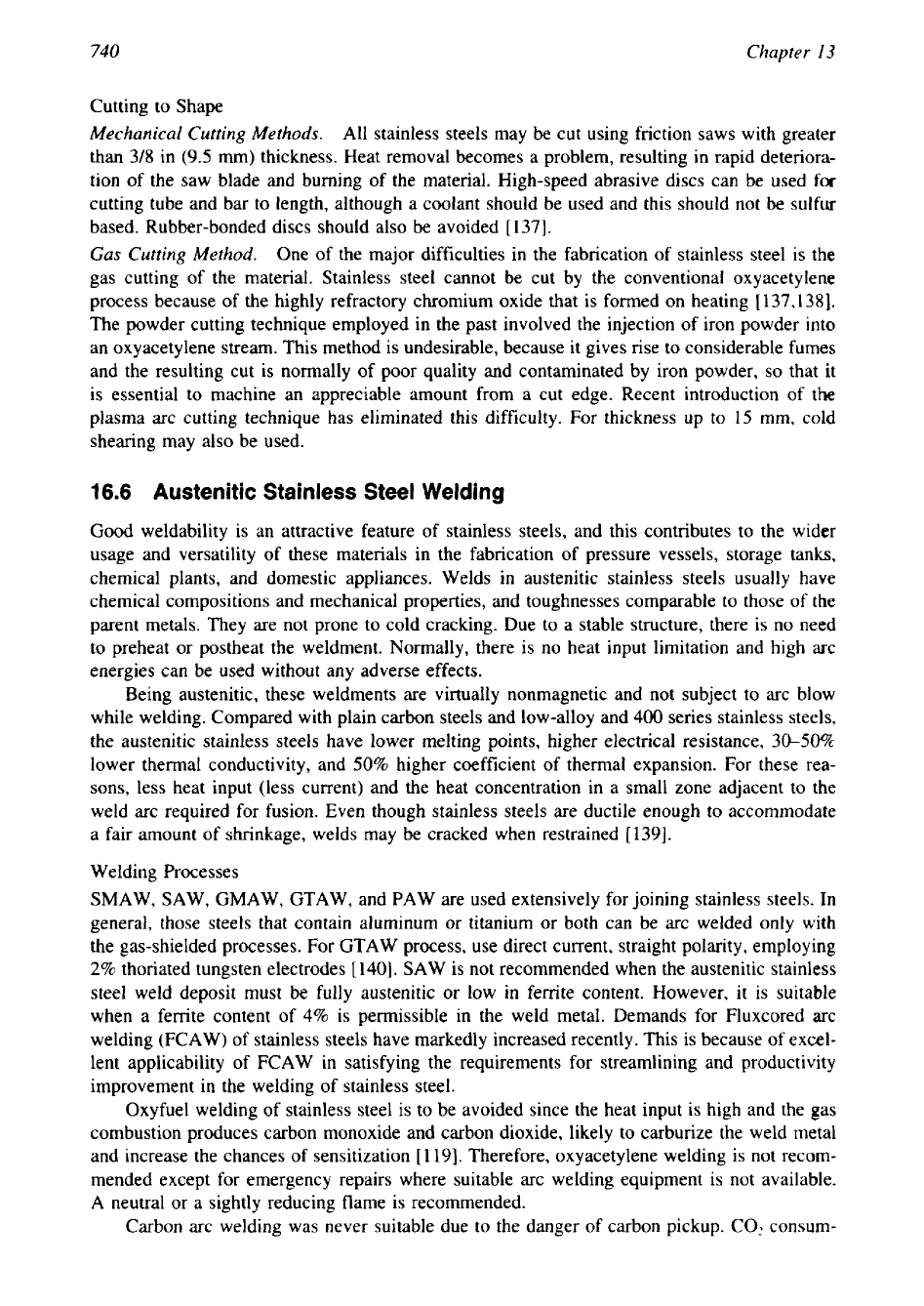
740
Chapter
I3
Cutting to Shape
Mechanical Cutting Methods.
All stainless steels may be cut using friction saws with greater
than 3/8 in
(9.5
mm) thickness. Heat removal becomes a problem, resulting in rapid deteriora-
tion of the saw blade and burning of the material. High-speed abrasive discs can be used for
cutting tube and bar to length, although a coolant should be used and this should not be sulfur
based. Rubber-bonded discs should also be avoided [137].
Gas
Cutting Method.
One of the major difficulties in the fabrication of stainless steel
is
the
gas cutting
of
the material. Stainless steel cannot be cut by the conventional oxyacetylene
process because of the highly refractory chromium oxide that is formed on heating [137,138].
The powder cutting technique employed in the past involved the injection of iron powder into
an oxyacetylene stream. This method is undesirable, because it gives rise to considerable fumes
and the resulting cut is normally of poor quality and contaminated by iron powder,
so
that it
is essential to machine an appreciable amount from a cut edge. Recent introduction of
the
plasma arc cutting technique has eliminated this difficulty. For thickness up to
15
mm, cold
shearing may also be used.
16.6
Austenitic Stainless Steel Welding
Good weldability is an attractive feature of stainless steels, and this contributes to the wider
usage and versatility of these materials in the fabrication of pressure vessels, storage tanks,
chemical plants, and domestic appliances. Welds in austenitic stainless steels usually have
chemical compositions and mechanical properties, and toughnesses comparable to those of the
parent metals. They are not prone to cold cracking. Due to a stable structure, there is no need
to preheat or postheat the weldment. Normally, there is no heat input limitation and high arc
energies can be used without any adverse effects.
Being austenitic, these weldments are virtually nonmagnetic and not subject to arc blow
while welding. Compared with plain carbon steels and low-alloy and 400 series stainless steels,
the austenitic stainless steels have lower melting points, higher electrical resistance,
30-5W0
lower thermal conductivity, and
50%
higher coefficient of thermal expansion. For these rea-
sons, less heat input (less current) and the heat concentration in a small zone adjacent to the
weld arc required for fusion. Even though stainless steels are ductile enough to accommodate
a fair amount of shrinkage, welds may be cracked when restrained
[139].
Welding Processes
SMAW, SAW, GMAW, GTAW, and PAW are used extensively for joining stainless steels. In
general, those steels that contain aluminum or titanium or both can be arc welded only with
the gas-shielded processes. For GTAW process, use direct current, straight polarity, employing
2%
thoriated tungsten electrodes
[
1401. SAW is not recommended when the austenitic stainless
steel weld deposit must be
fully
austenitic or low in ferrite content. However, it is suitable
when a ferrite content of 4% is permissible in the weld metal. Demands for Fluxcored arc
welding (FCAW) of stainless steels have markedly increased recently. This is because of excel-
lent applicability of FCAW in satisfying the requirements for streamlining and productivity
improvement in the welding of stainless steel.
Oxyfuel welding of stainless steel is to be avoided since the heat input is high and the gas
combustion produces carbon monoxide and carbon dioxide, likely to carburize the weld metal
and increase the chances of sensitization
[
1
193.
Therefore, oxyacetylene welding is not recom-
mended except for emergency repairs where suitable arc welding equipment
is
not available.
A neutral or a sightly reducing flame is recommended.
Carbon arc welding was never suitable due to the danger
of
carbon pickup.
CO2
consum-

741
Material Selection and Fabrication
able electrode welding can be used in applications in which corrosion can be tolerated. When
corrosion resistance is a major factor, metal arc welding with covered electrodes or one of the
inert gas processes can be used
[
1371.
The welding of stainless steels has been reviewed extensively by Fenn
[
1361, Banks
[
1371,
Weymuller [139], Beigay et al. [140,141], and Castro and deCadnet [142], and the topic has
been updated more recently by Castner [143]. Various aspects of
SS
welding are discussed
next.
Filler Metal Selection
In order to optimize the properties of stainless welds, careful selection of welding consumables
and fabrication procedures is mandatory. AWS
A5.4,
Specification for Corrosion Resisting
Chromium and Chromium-Nickel Steel Covered Welding Electrodes, lists types, compositions,
and other data for standard electrodes. AWS ER 3xx filler metals or overmatching
300
series
filler metals are used in over 90% of stainless steel welding applications. Such welds exhibit
good corrosion resistance, toughness, and excellent strength at both low and high temperatures,
and a high degree of toughness in the as-welded condition. A few recommended filler metals
and the austenitic steel base metals are given in Table
20.
Shielding Gases
Single gases or mixtures of different gases such as argon, helium, oxygen, carbon dioxide,
hydrogen, nitrogen, and nitrogen monoxide
(NO)
in fairly different proportions can be used in
GMAW
of
SS.
Weld Preparation
Weld preparations for stainless steels are similar to those used for carbon steels and may be
obtained by machining, grinding, or plasma cutting.
Joint Design
Weld penetration is generally less in stainless steels than in carbon steels,
so
weld preparation
angles are greater, root faces smaller, and root gaps wider; greater welding skill is required to
ensure that adequate penetration is achieved without root defects
[
1371. A typical joint design
for stainless steel is shown in Fig. 19.
Preweld Cleaning
To
obtain sound welds free from cracks or embrittlements, the surfaces to be joined require
cleaning prior to welding. The area to be cleaned should include the weld groove faces and
Table
20
Filler Metals for Austenitic Stainless Steels
Filler metal Base metal
AWS E308
or
ER308
Types 405, 409, 410, 430, 304
AWS E308L or ER308L
Types 304L, 304, 321, 347
AWS E3 16
or
ER3 16
Types 304, 317
AWS E3 16L or ER3 16L
Types 321, 347
AWS E317
or
ER317L
Type 304
AWS E347
or
ER347
Types 304, 304L, 321, 347
Note.
This table was compiled
from
Beigay et al.
[140].
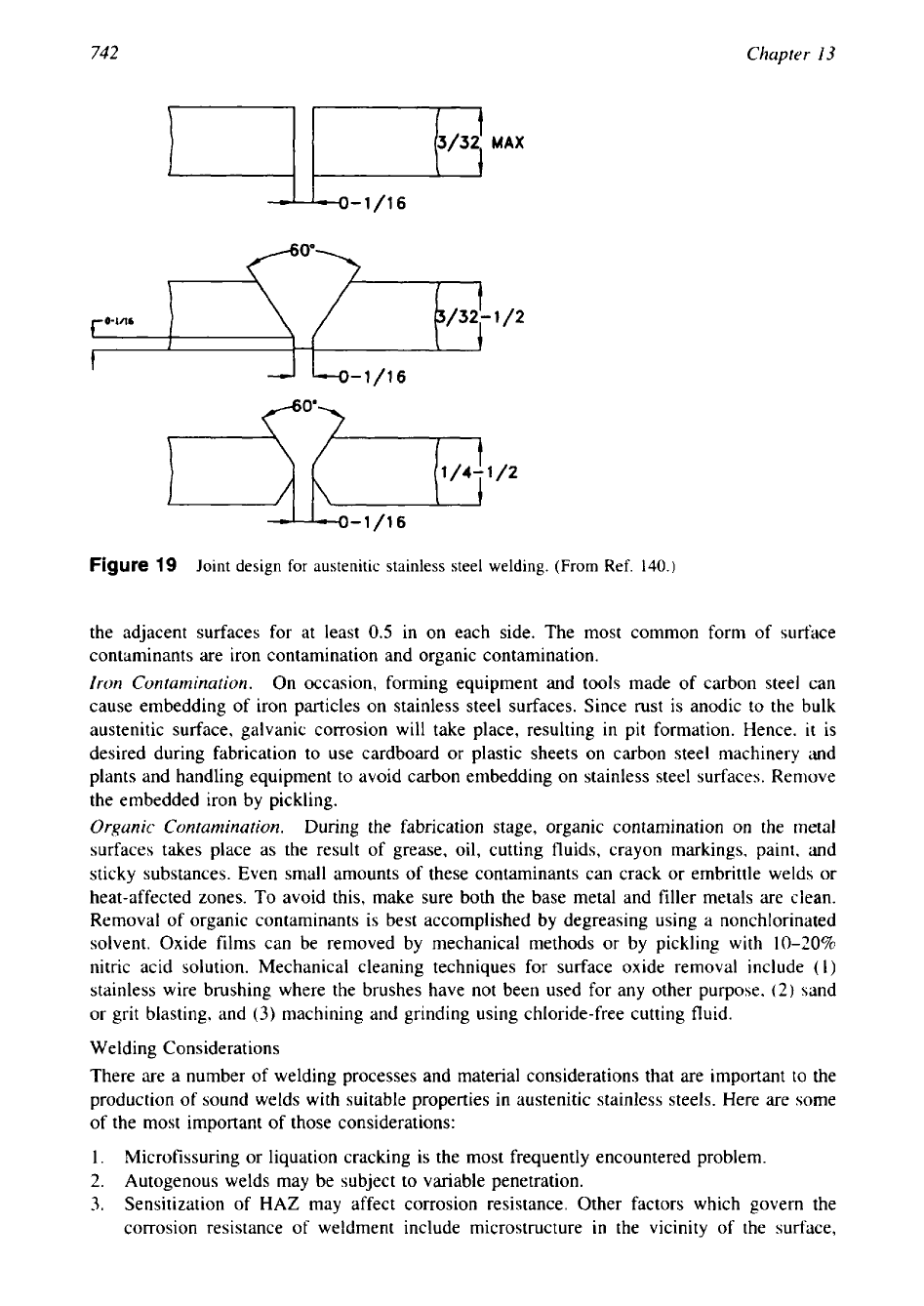
742
Chapter 13
-I
4-1/16
Figure
19
Joint design
for
austenitic stainless steel welding.
(From
Ref.
140.)
the adjacent surfaces for
at
least
0.5
in on each side. The most common form of surface
contaminants are iron contamination and organic contamination.
Iron Contarnination.
On occasion, forming equipment and tools made of carbon steel can
cause embedding of iron particles on stainiess steel surfaces. Since rust is anodic
te
the bulk
austenitic surface, galvanic corrosion will take place, resulting ir, pit formation. Hence, it is
desired during fabrication to use cardboard or p!astic sheets on carbon steel machinery and
plants and handling equipment to avoid carbon embedding on staicless steel surfaces. Remove
the embedded iron by pickling.
Organic Contamination.
During the fabrication stage, organic contamination on the metal
surfaces takes place
as
the result of grease, oil, cutting fluids, crayon markings, pain:, and
sticky substances. Even small amounts of these contaminants can crack or embrittle welds or
heat-affected zones.
To
avoid this, make sure both the base metal and filler metals are clean.
Removal of organic contaminants is best accomplished by degreasing using a nonchlorinated
solvent. Oxide films can be removed by mechanical methods or by pickling with
10-20%
nitric acid solution. Mechanical cleaning techniques for surface oxide removal include
(1)
stainless wire brushing where the brushes have not been used for any other purpose,
(2)
sand
~
or grit blasting, and
(3)
machining and grinding using chloride-free cutting fluid.
Welding Considerations
There are a number
nf
welding processes and material considerations that are important
to
the
production of sound welds with suitable properties in austenitic stainless steels. Here are some
of the most importaxt of those considerations:
1.
Microfissuring or liquation cracking is the most frequently encountered problem
2.
Autogenous welds may be sabject to variable penetration.
3.
Sensitization of HAZ may affect corrosion resistance. Other factors which govern the
corrosion resistance
of
weldment include microstructure in the vicinity of the surface,

743
Material Selection and Fabrication
inclusions, surface oxides, residual weld stresses, spotter, and contaminations and geomet-
ric surface defects and crevices
[
1 181.
4.
Greater thermal expansion may result in warping or distortion, especially
in
thin sections,
suggesting greater need for jigging to maintain dimensional control.
5.
Welding fumes present potential hazards to workers.
6.
Several factors must be considered when postweld heat treatment (PWHT) is required.
7.
Dissimilar metal weld joints require selection of proper filler metal and procedures.
Microfissuring
or
Liquation Cracking
in
Austenitic Stainless Steel Weld.
The structures of
most importance in the weldable stainless steels are ferrite and austenite. The structure of
austenitic stainless steel weld metals varies from fully austenitic in Type 310 to dual-phase
austenitic-ferritic in Types 304, 308, 309, 312, and 316. Fully austenitic alloys tend to be hot
short, and welds in these materials show fine cracking or microfissuring, also known as liqua-
tion cracking, either
in
the weld metal itself or in the heat-affected zone, while those that
solidify with delta ferrite as the primary solidification mode are the least susceptible to hot
cracking.
Segregation of low-melting-point impurities like
S,
Si, and P between the grain boundaries
can cause liquation cracking or microfissuring in the weldment, the HAZ, and weld overlays.
Shrinkage stresses combined with high restraint (clamping is often used on stainless steel
during welding to prevent distortion) may cause these films to rupture prior
to
complete solidi-
fication
[
1441. Each element exhibits detrimental effects on hot cracking. Phosphorus content
above 0.025%, sulfur content above
0.025%,
or silicon content above 2.0% may cause the
same length of solidification crack. The combined effect
of
these impurities may be much
more disastrous
[
1451.
HAZ Liquation Cracking Susceptible Alloys. Austenitic stainless steels susceptible to
HAZ liquation cracking include AISI 304, 304L, and the stabilized grades such as Type 321
and Type 347. HAZ liquation cracking has been reported in both cast and wrought versions of
a wide variety of nickel-base alloys such as Incoloy Alloy
800,
Alloy 718, and Hastelloy
X
~721.
Avoiding liquation cracking is the most important issue in fusion welding of austenitic
stainless steels. In general, alloys that solidified with ferrite as the primary phase and contain-
ing 4-1 1%
by
volume of ferrite in the as-welded condition were more resistant to cracking than
alloys solidified as austenite. Hence, in order to control microfissuring in stainless welding, the
alloying elements are balanced in such a way as to attempt to produce a weld deposit contain-
ing ferrite in the order of 4 to 11 FN (ferrite number). The ferrite number is a magnetically
determined scale of ferrite measurement. This provides sufficient control in most applications
where minimum ferrite content or a ferrite range is specified.
Benefits of Ferrite in Austenitic
SS.
Major benefits of ferrite to austenitic stainless weld
metal are improved resistance to microfissuring and hot cracking, improved resistance to stress
corrosion cracking, and good low-temperature impact strength
[
1441.
Optimum Weld Metal Ferrite Content.
It is a common practice today to specify a mini-
mum ferrite content about 3 or 4 FN in a nominal austenitic stainless steel weld metal to
provide assurance that the weld will be free of hot cracks and microfissures. Following are the
minimum recommended levels of weld metal ferrite content (a range of 8 to 10
FN
is consid-
ered optimum under most conditions) for various types of austenitic stainless steels
[
1441:
Type 308/308L, 3 FN
Type 309/309L,
5
FN
Type 3 16/3 16L, 3 FN
Type 347, 6 FN
